Effects of Ground Subsidence on Permafrost Simulation Related to Climate Warming
Abstract
:1. Introduction
2. Methods
2.1. Study Areas and Observations
2.2. Numerical Model
2.3. Forcing Data
2.4. Experimental Design
3. Results
3.1. Ground Subsidence and Permafrost Change Trajectories
3.2. Comparison of Ground Temperature Simulations
3.3. Error Calculation of Heat Consumption for Permafrost Changes
4. Discussion
5. Conclusions
- Wudaoliang and Tanggula are in the continuous permafrost zone of the QTP. The underlying permafrost is presently in the low-temperature stage there. This is associated with minimal ground subsidence. Therefore, the improvement of the simulation performance is relatively small in the moving-mesh model considering ground subsidence during the observation period. Projections indicate that the permafrost at the two study sites will be close to the zero-gradient stage in 2030–2040 under the SSP5-8.5 scenario. By that stage, there may be a high risk of ground surface settlement and the effects of ground subsidence on permafrost simulation may be significant.
- Ground subsidence plays a role in the trajectory of the permafrost change, ground temperature field and heat consumption in a permafrost simulation. Permafrost simulation without ground subsidence consideration tends to achieve a larger active layer thickness and to underestimate the permafrost thawing and the heat consumption. These effects increase with time, while the differences in the ground temperature field simulation caused by ground subsidence are dependent on the permafrost degradation stages.
- Permafrost regions with rich ground ice may not necessarily have a larger error in the simulated ground temperature field but will generate a larger heat calculation error in permafrost simulations that do not consider ground subsidence during a warming climate. In other words, ignoring ground subsidence may lead to a large quantity of heat in the energy budget being allocated to other climate system components rather than being consumed in ice-rich permafrost thaw, although the error within the simulated characteristic parameter related to deep permafrost layers, such as the permafrost base, ZAA and MAGT, may be not significant. Therefore, permafrost projections for the QTP where the permafrost regions are characteristic of ice-rich and high ground temperature regions should consider the ground subsidence process.
Author Contributions
Funding
Institutional Review Board Statement
Informed Consent Statement
Data Availability Statement
Conflicts of Interest
References
- Wang, W.; Rinke, A.; Moore, J.C.; Cui, X.; Ji, D.; Li, Q.; Zhang, N.; Wang, C.; Zhang, S.; Lawrence, D.M. Diagnostic and model dependent uncertainty of simulated Tibetan permafrost area. Cryosphere 2016, 10, 287–306. [Google Scholar] [CrossRef]
- Riseborough, D.; Shiklomanov, N.; Etzelmüller, B.; Gruber, S.; Marchenko, S. Recent advances in permafrost modelling. Permafr. Periglac. Process. 2008, 19, 137–156. [Google Scholar] [CrossRef]
- Qin, D.; Yao, T.; Ding, Y.; Ren, J. Glossary of Cryospheric Science; China Meeorological Press: Beijing, China, 2016. [Google Scholar]
- Zhang, Z.; Wu, Q. Thermal hazards zonation and permafrost change over the Qinghai–Tibet Plateau. Nat. Hazards 2012, 61, 403–423. [Google Scholar] [CrossRef]
- Jin, H.; Wei, Z.; Wang, S.; Yu, Q.; Lü, L.; Wu, Q.; Ji, Y. Assessment of frozen-ground conditions for engineering geology along the Qinghai-Tibet highway and railway, China. Eng. Geol. 2008, 101, 96–109. [Google Scholar] [CrossRef]
- Wang, C.; Wang, Z.; Kong, Y.; Zhang, F.; Yang, K.; Zhang, T. Most of the Northern Hemisphere permafrost remains under climate change. Sci. Rep. 2019, 9, 3295. [Google Scholar] [CrossRef] [PubMed]
- Biskaborn, B.K.; Smith, S.L.; Noetzli, J.; Matthes, H.; Vieira, G.; Streletskiy, D.A.; Schoeneich, P.; Romanovsky, V.E. Permafrost is warming at a global scale. Nat. Commun. 2019, 10, 264. [Google Scholar] [CrossRef] [PubMed]
- Luo, D.; Wu, Q.; Jin, H.; Marchenko, S.S.; Lü, L.; Gao, S. Recent changes in the active layer thickness across the northern hemisphere. Environ. Earth Sci. 2016, 75, 555. [Google Scholar] [CrossRef]
- Droppo, I.G.; Cenzo, P.D.; Mcfadyen, R.; Reid, T. Assessment of the sediment and associated nutrient/contaminant continuum, from permafrost thaw slump scars to tundra lakes in the western Canadian Arctic. Permafr. Periglac. Process. 2022, 33, 32–45. [Google Scholar] [CrossRef]
- Mu, C.; Shang, J.; Zhang, T.; Fan, C.; Jia, L. Acceleration of thaw slump during 1997–2017 in the Qilian Mountains of the northern Qinghai-Tibetan plateau. Landslides 2020, 17, 1051–1062. [Google Scholar] [CrossRef]
- Luo, J.; Niu, F.; Lin, Z.; Liu, M.; Yin, G. Recent acceleration of thaw slumping in permafrost terrain of Qinghai-Tibet Plateau: An example from the Beiluhe Region. Geomorphology 2019, 341, 79–85. [Google Scholar] [CrossRef]
- Jin, H.; Wu, Q.; Romanovsky, V.E. Degrading permafrost and its impacts. Adv. Clim. Chang. Res. 2021, 12, 1–5. [Google Scholar] [CrossRef]
- Abbott, B.W.; Jones, J.B. Permafrost collapse alters soil carbon stocks, respiration, CH4, and N2O in upland tundra. Glob. Chang. Biol. 2015, 21, 4570–4587. [Google Scholar] [CrossRef] [PubMed]
- Wu, X.; Lin, Z.; Liu, G.; Xu, H.; Zhang, X.; Ding, Y. Effects of permafrost thaw-subsidence on soil bacterial communities in the southern Qinghai-Tibetan Plateau. Appl. Soil Ecol. 2018, 128, 81–88. [Google Scholar] [CrossRef]
- Abolt, C.J.; Young, M.H.; Atchley, A.L.; Harp, D.R.; Coon, E.T. Feedbacks between surface deformation and permafrost degradation in ice wedge polygons, Arctic Coastal Plain, Alaska. J. Geophys. Res. Earth Surf. 2020, 125, e2019JF005349. [Google Scholar] [CrossRef]
- Cai, L.; Lee, H.; Aas, K.S.; Westermann, S. Projecting circum-Arctic excess-ground-ice melt with a sub-grid representation in the Community Land Model. Cryosphere 2020, 14, 4611–4626. [Google Scholar] [CrossRef]
- Westermann, S.; Langer, M.; Boike, J.; Heikenfeld, M.; Peter, M.; Etzelmüller, B.; Krinner, G. Simulating the thermal regime and thaw processes of ice-rich permafrost ground with the land-surface model CryoGrid 3. Geosci. Model Dev. 2016, 9, 523–546. [Google Scholar] [CrossRef]
- Lee, H.; Swenson, S.C.; Slater, A.G.; Lawrence, D.M. Effects of excess ground ice on projections of permafrost in a warming climate. Environ. Res. Lett. 2014, 9, 1748–9326. [Google Scholar] [CrossRef]
- Painter, S.L.; Coon, E.T.; Khattak, A.J.; Jastrow, J.D. Drying of tundra landscapes will limit subsidence-induced acceleration of permafrost thaw. Proc. Natl. Acad. Sci. USA 2023, 120, e2212171120. [Google Scholar] [CrossRef]
- Buteau, S.; Fortier, R.; Delisle, G.; Allard, M. Numerical simulation of the impacts of climate warming on a permafrost mound. Permafr. Periglac. Process. 2004, 15, 41–57. [Google Scholar] [CrossRef]
- Nitzbon, J.; Westermann, S.; Langer, M.; Martin, L.C.P.; Strauss, J.; Laboor, S.; Boike, J. Fast response of cold ice-rich permafrost in northeast Siberia to a warming climate. Nat. Commun. 2020, 11, 2201. [Google Scholar] [CrossRef]
- Wagner, A.M.; Lindsey, N.J.; Shan, D.; Arthur, G.; Stephanie, S.; Christopher, W.; Ian, E.; Craig, U.; Sharon, B.; Alejandro, M. Permafrost degradation and subsidence observations during a controlled warming experiment. Sci. Rep. 2018, 8, 10908. [Google Scholar] [CrossRef] [PubMed]
- Liu, S.; Zhao, L.; Wang, L.; Zhou, H.; Zou, D.; Sun, Z.; Changwei, X.; Qiao, Y. Intra-annual ground surface deformation detected by site observation, simulation and InSAR monitoring in permafrost site of Xidatan, Qinghai-Tibet Plateau. Geophys. Res. Lett. 2022, 49, e2021GL095029. [Google Scholar] [CrossRef]
- Lawrence, D.M.; Slater, A.G. A projection of severe near-surface permafrost degradation during the 21st century. Geophys. Res. Lett. 2005, 32, L24401. [Google Scholar] [CrossRef]
- Smith, S.L.; O’Neill, H.B.; Isaksen, K.; Noetzli, J.; Romanovsky, V.E. The changing thermal state of permafrost. Nat. Rev. Earth Environ. 2022, 3, 10–23. [Google Scholar] [CrossRef]
- Stevens, M.B.; Smerdon, J.E.; González-Rouco, J.F.; Stieglitz, M.; Beltrami, H. Effects of bottom boundary placement on subsurface heat storage: Implications for climate model simulations. Geophys. Res. Lett. 2007, 34, 170–206. [Google Scholar] [CrossRef]
- Sun, Z.; Zhao, L.; Hu, G.; Qiao, Y.; Zhou, H.; Liu, S.; Du, E.; Zou, D.; Xie, C. Numerical simulation of thaw settlement and permafrost changes at three sites along the Qinghai-Tibet Engineering Corridor in a warming climate. Geophys. Res. Lett. 2022, 49, e2021GL097334. [Google Scholar] [CrossRef]
- Wu, J.C.; Yu, S.; Wu, Q.B.; Zhi, W. Processes and modes of permafrost degradation on the Qinghai-Tibet Plateau. Sci. China Earth Sci. 2010, 53, 150–158. [Google Scholar] [CrossRef]
- Jin, H.; Lin, Z.; Wang, S.; Rui, J. Thermal regimes and degradation modes of permafrost along the Qinghai-Tibet Highway. Sci. China 2006, 49, 1170–1183. [Google Scholar] [CrossRef]
- Zhao, L.; Zou, D.; Hu, G.; Wu, T.; Du, E.; Liu, G.; Xiao, Y.; Li, R.; Pang, Q.; Qiao, Y.; et al. A synthesis dataset of permafrost thermal state for the Qinghai-Xizang (Tibet) Plateau, China. Earth Syst. Sci. Data 2021, 13, 4207–4218. [Google Scholar] [CrossRef]
- Yershov, E.D. Principles of Gocryology; Lanzhou University Press: Lanzhou, China, 2015. [Google Scholar]
- Pullman, E.R.; Jorgenson, M.T.; Shur, Y. Thaw settlement in soils of the Arctic Coastal Plain, Alaska. Arctic Antarct. Alp. Res. 2007, 39, 468–476. [Google Scholar] [CrossRef]
- GB 50007-2011; Code for Design of Soil and Foundation of Building in Frozen Soil Region. China Architecture and Building Press: Beijing, China, 2011.
- GB 50324-2014; Code for Engineering Geological Investigation of Frozen Ground. China Planning Press: Beijing, China, 2014.
- IPCC. Special Report on the Ocean and Cryosphere in a Changing Climate. Available online: https://archiveipccch/srocc/ (accessed on 29 November 2022).
- Iturbide, M.; Gutiérrez, J.M.; Alves, L.M.; Bedia, J.; Cerezo-Mota, R.; Cimadevilla, E.; Cofiño, A.S.; Di Luca, A.; Faria, S.H.; Gorodetskaya, I.V. An update of IPCC climate reference regions for subcontinental analysis of climate model data: Definition and aggregated datasets. Earth Syst. Sci. Data 2020, 12, 2959–2970. [Google Scholar] [CrossRef]
- Nash, J.E.; Sutcliffe, J.V. River flow forecasting through conceptual models part I—A discussion of principles. J. Hydrol. 1970, 10, 282–290. [Google Scholar] [CrossRef]
- Li, X.; Cheng, G.; Jin, H.; Kang, E.; Che, T.; Jin, R.; Wu, L.; Nan, Z.; Wang, J.; Shen, Y. Cryospheric change in China. Glob. Planet. Chang. 2008, 62, 210–218. [Google Scholar] [CrossRef]
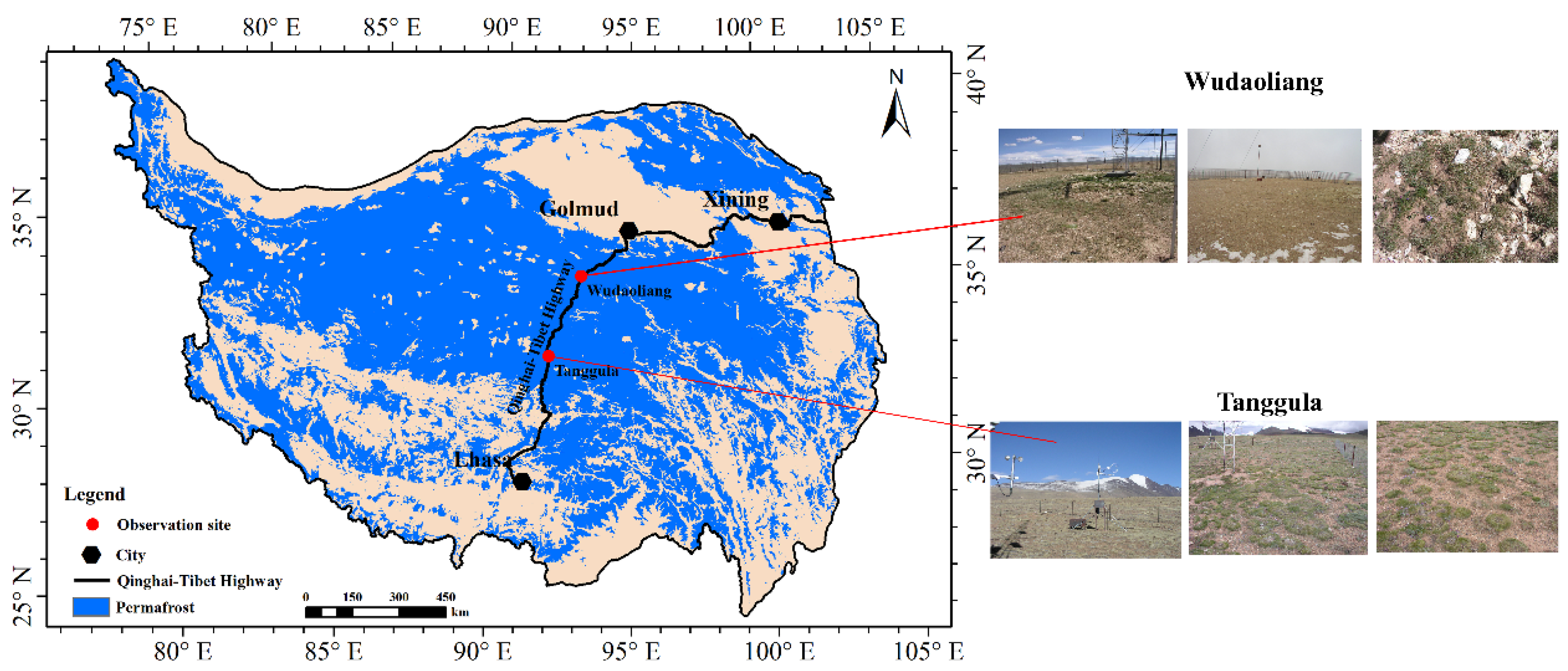

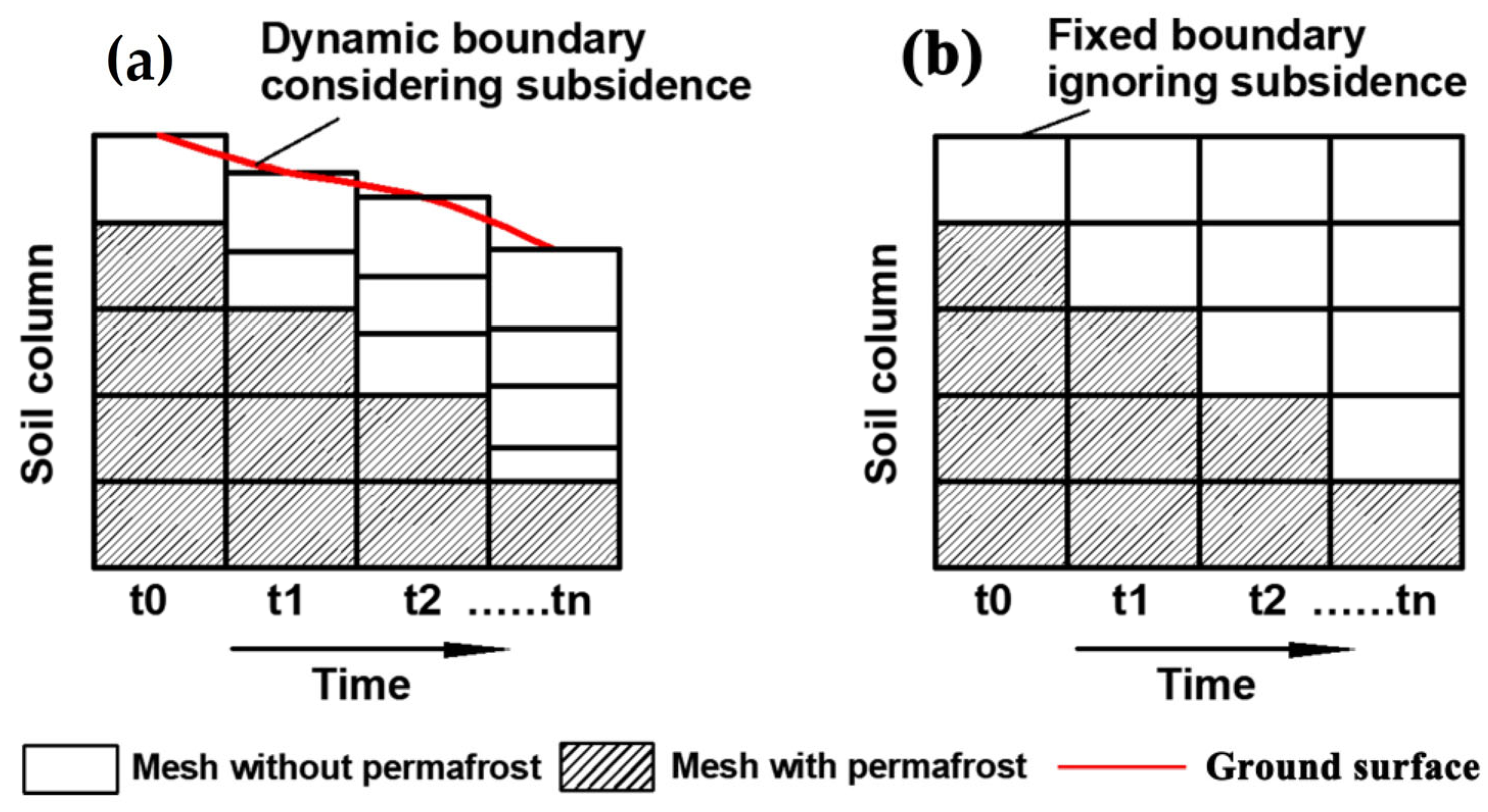
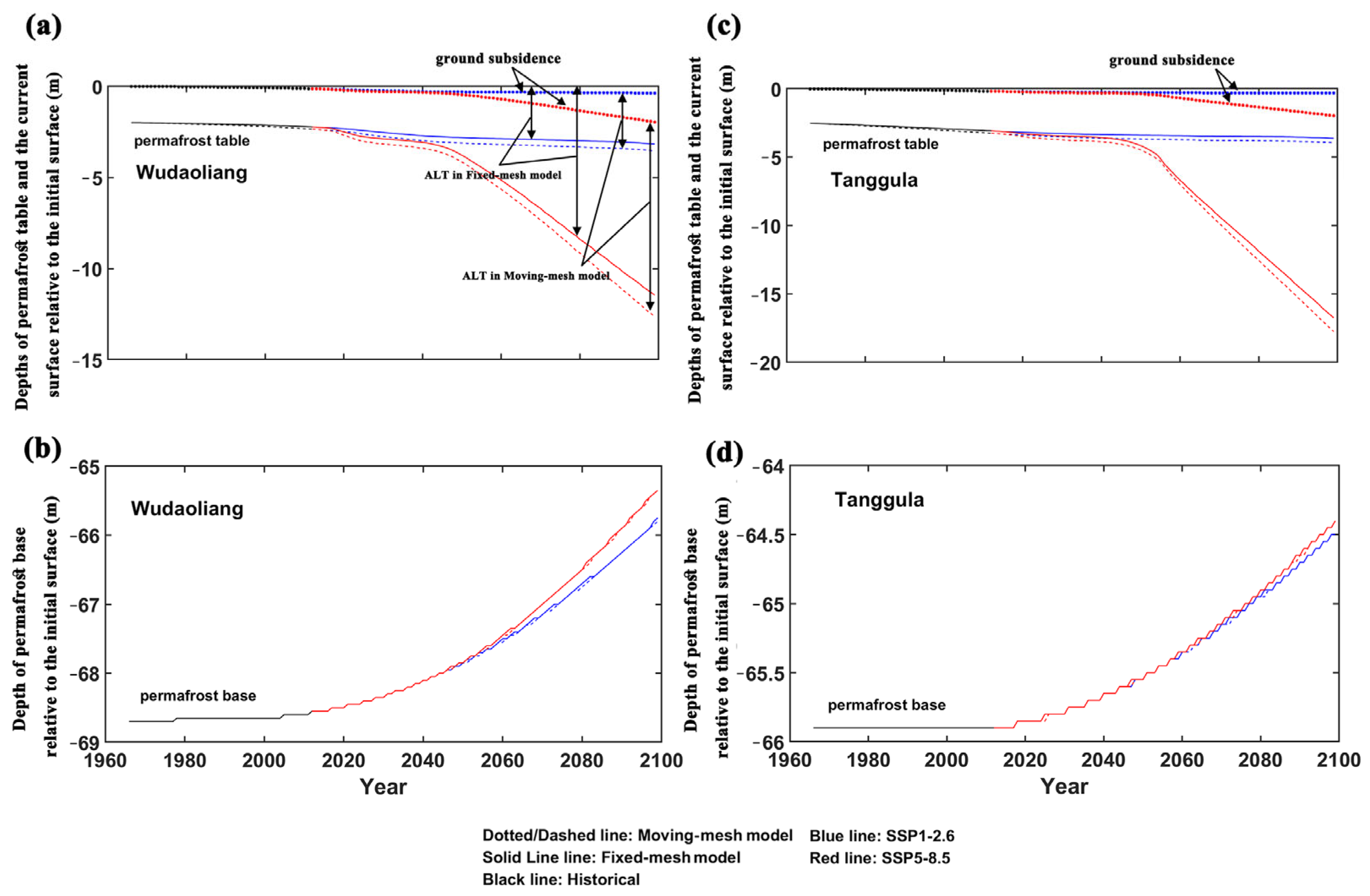
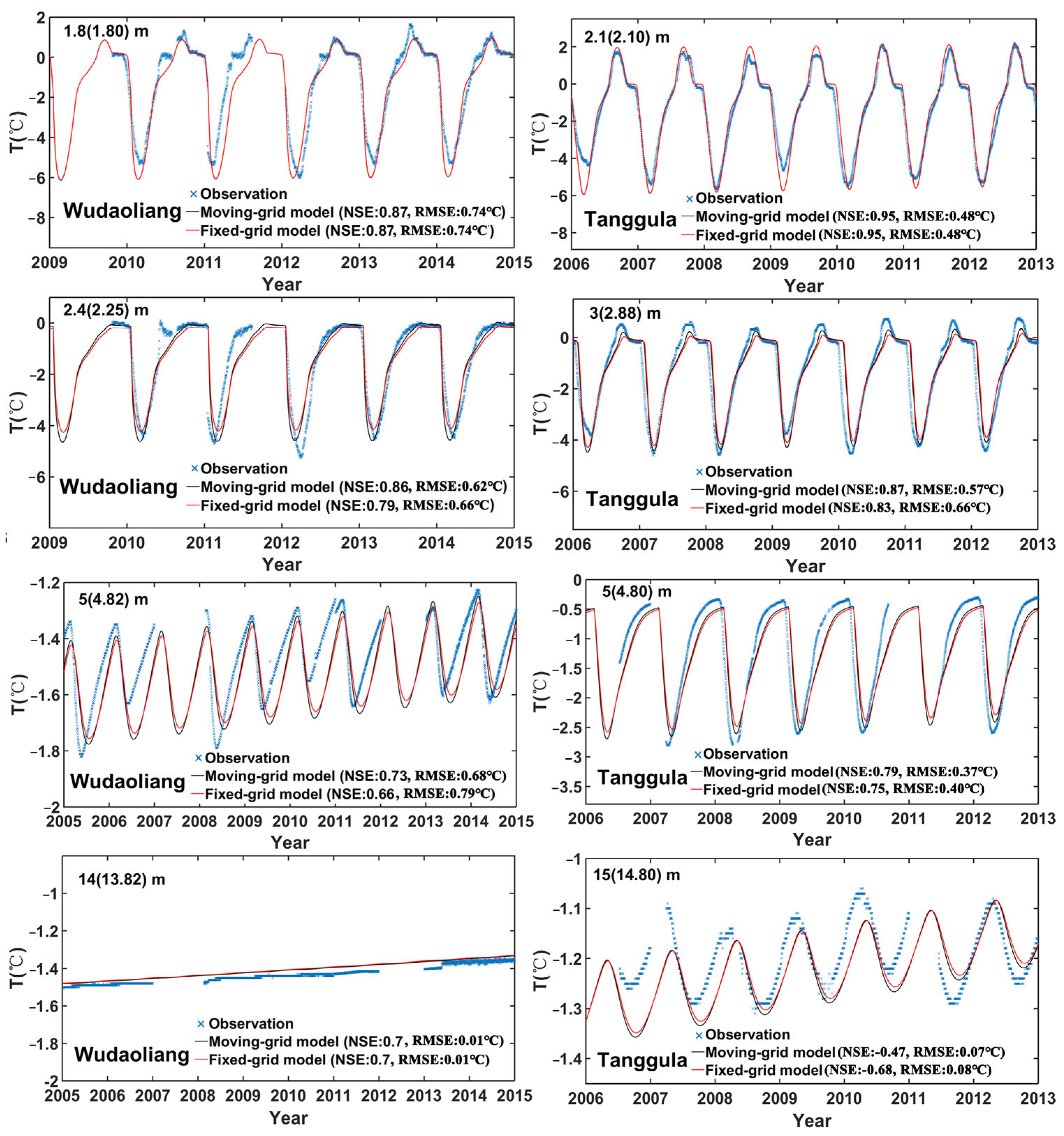
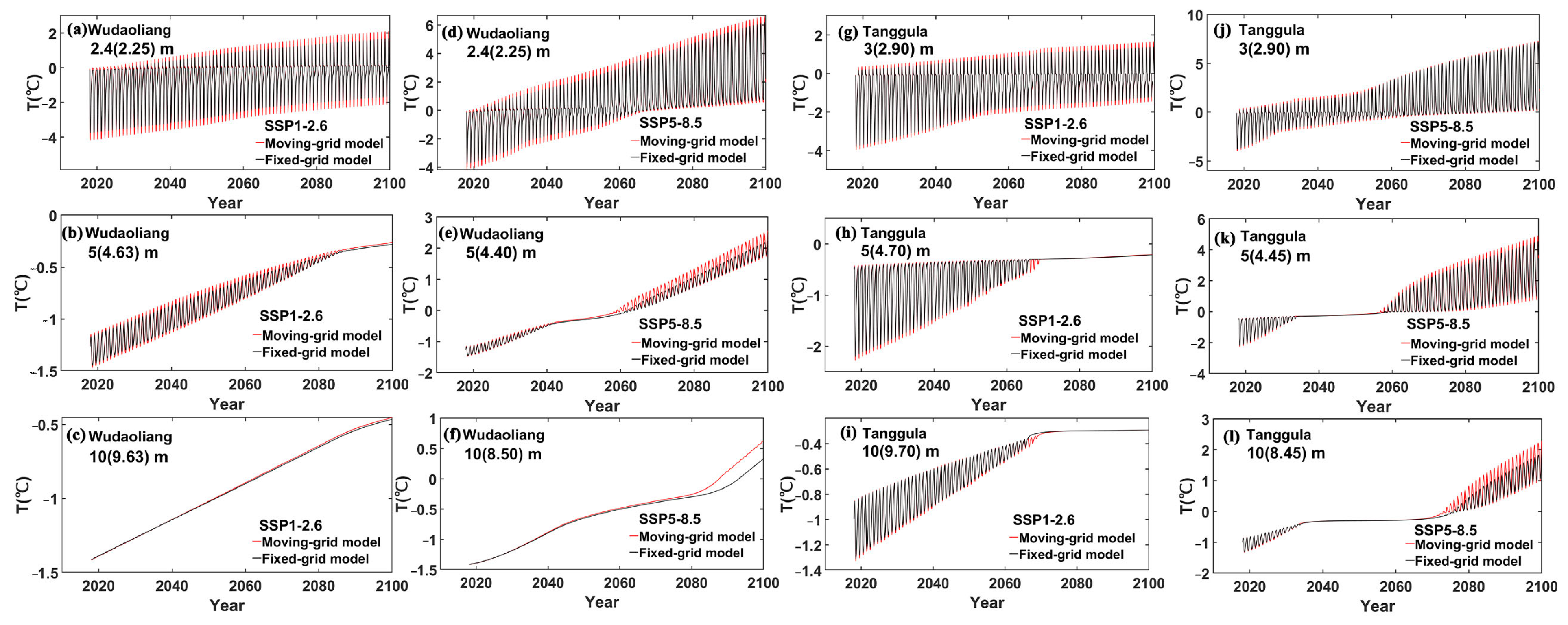
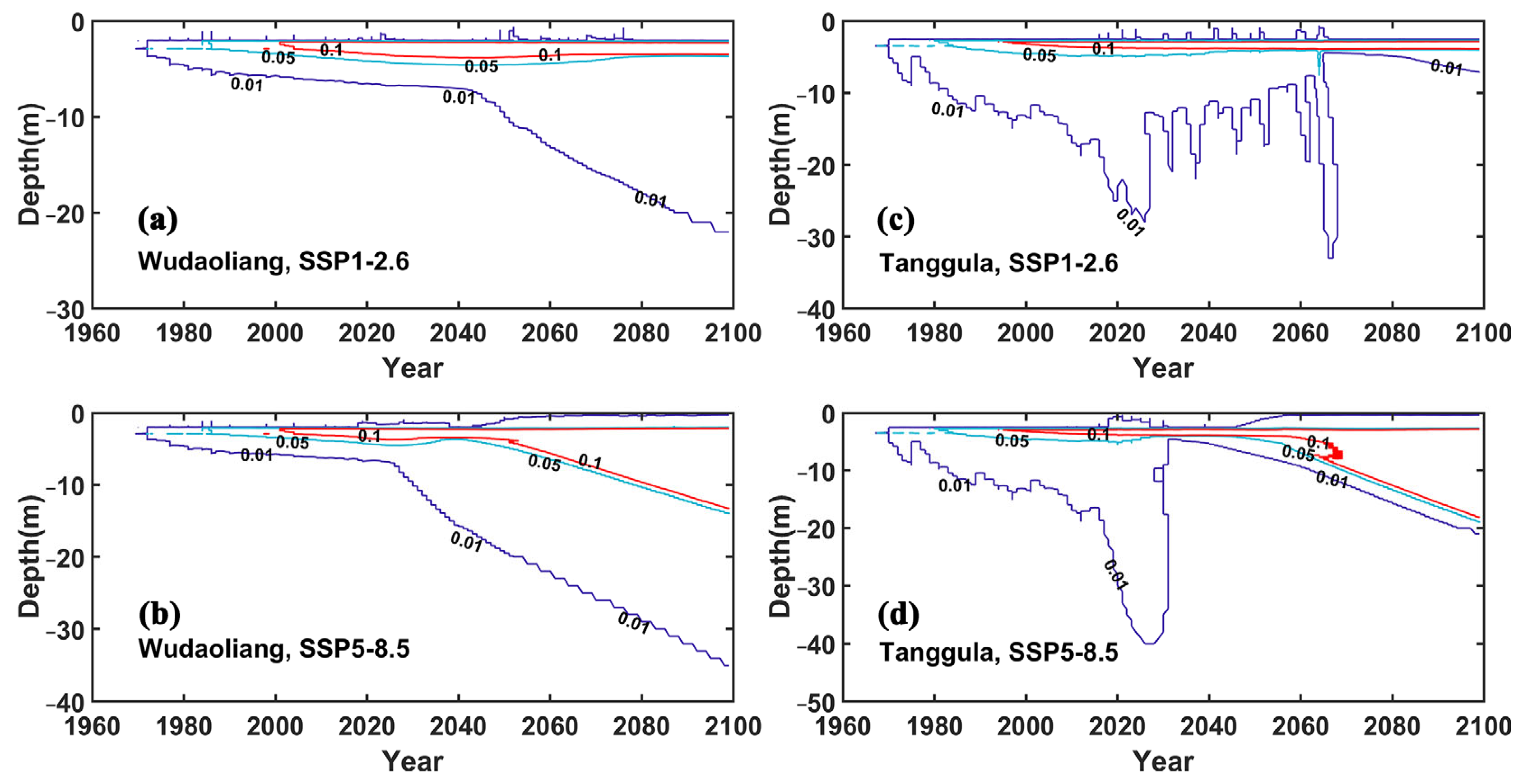

| Soil Texture | λ (w/(m·°C) | c (103 kJ/(m³·°C)) | A | (%) |
|---|---|---|---|---|
| Sandy loam | 0.72~2.16 | 1.7~3.5 | 0.7 | 18 |
| Sand | 0.92~2.4 | 1.6~3.1 | 0.6 | 14 |
| Sand with grave | 1.33~3.3 | 1.7~3.2 | 0.6 | 14 |
| Gravel soil | 1.1~3.1 | 1.8~3.2 | 0.5 | 11 |
| Sedimentary-cemented rock | 0.1~6.5 | 0.33~2.3 | 0.6 | 10 |
| Ice-layer with soil | 0.73~2.15 | 1~4 | 1.1 | 30 |
Disclaimer/Publisher’s Note: The statements, opinions and data contained in all publications are solely those of the individual author(s) and contributor(s) and not of MDPI and/or the editor(s). MDPI and/or the editor(s) disclaim responsibility for any injury to people or property resulting from any ideas, methods, instructions or products referred to in the content. |
© 2023 by the authors. Licensee MDPI, Basel, Switzerland. This article is an open access article distributed under the terms and conditions of the Creative Commons Attribution (CC BY) license (https://creativecommons.org/licenses/by/4.0/).
Share and Cite
Sun, Z.; Zhao, L.; Hu, G.; Zhou, H.; Liu, S.; Qiao, Y.; Du, E.; Zou, D.; Xie, C. Effects of Ground Subsidence on Permafrost Simulation Related to Climate Warming. Atmosphere 2024, 15, 12. https://doi.org/10.3390/atmos15010012
Sun Z, Zhao L, Hu G, Zhou H, Liu S, Qiao Y, Du E, Zou D, Xie C. Effects of Ground Subsidence on Permafrost Simulation Related to Climate Warming. Atmosphere. 2024; 15(1):12. https://doi.org/10.3390/atmos15010012
Chicago/Turabian StyleSun, Zhe, Lin Zhao, Guojie Hu, Huayun Zhou, Shibo Liu, Yongping Qiao, Erji Du, Defu Zou, and Changwei Xie. 2024. "Effects of Ground Subsidence on Permafrost Simulation Related to Climate Warming" Atmosphere 15, no. 1: 12. https://doi.org/10.3390/atmos15010012
APA StyleSun, Z., Zhao, L., Hu, G., Zhou, H., Liu, S., Qiao, Y., Du, E., Zou, D., & Xie, C. (2024). Effects of Ground Subsidence on Permafrost Simulation Related to Climate Warming. Atmosphere, 15(1), 12. https://doi.org/10.3390/atmos15010012







